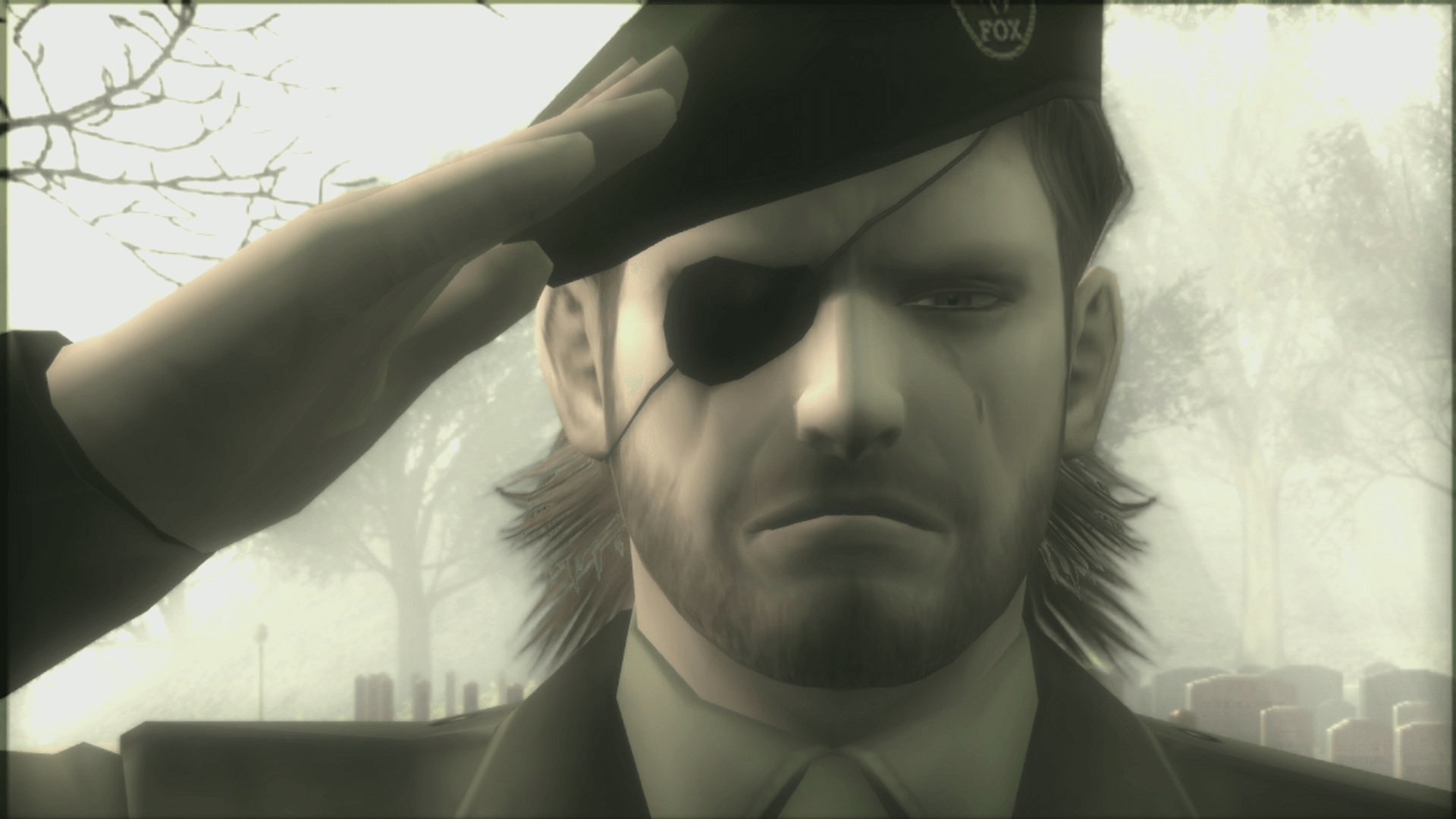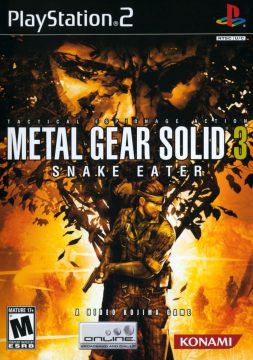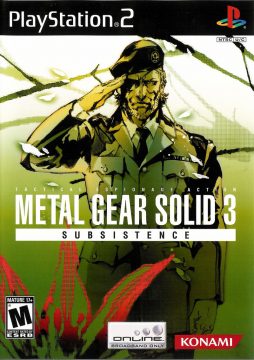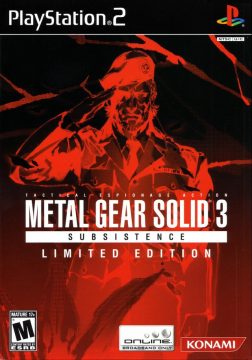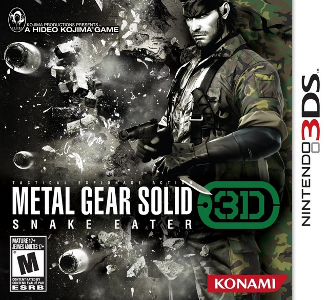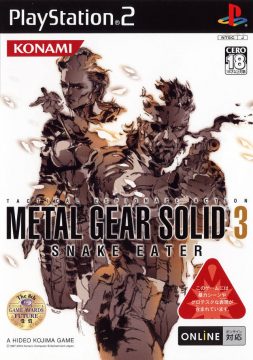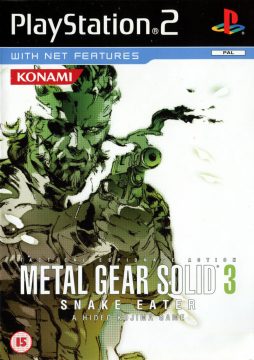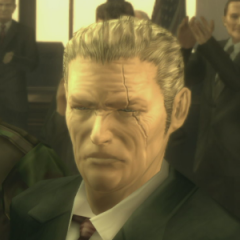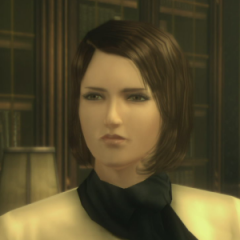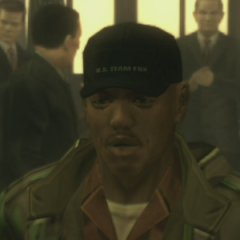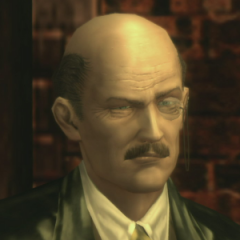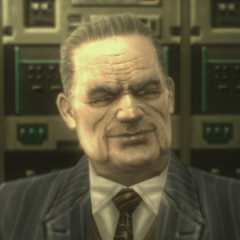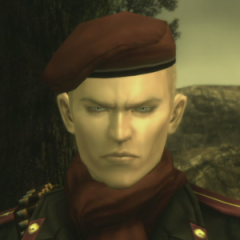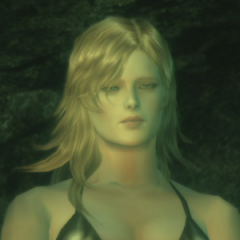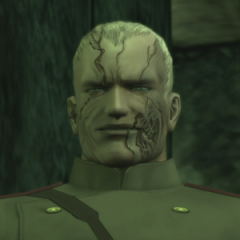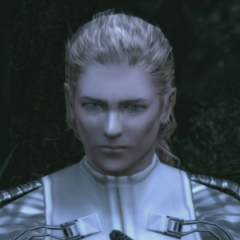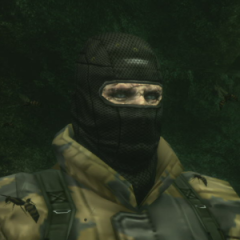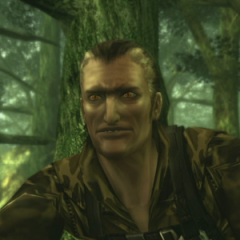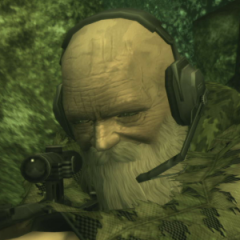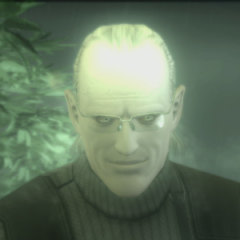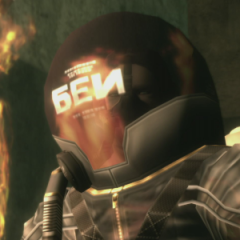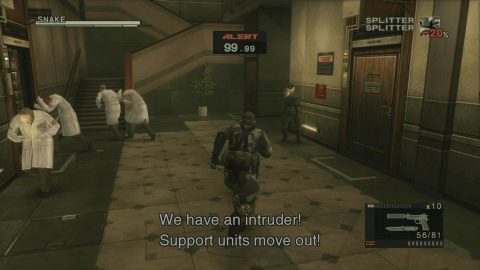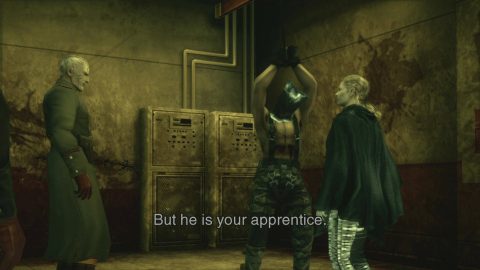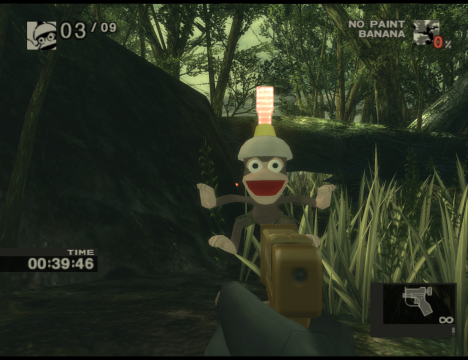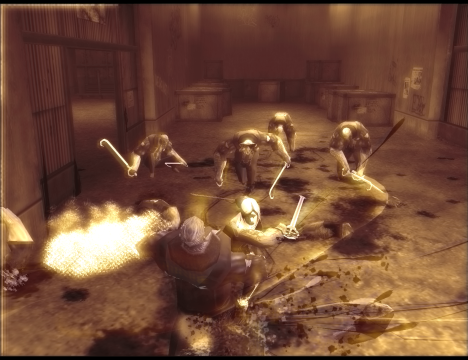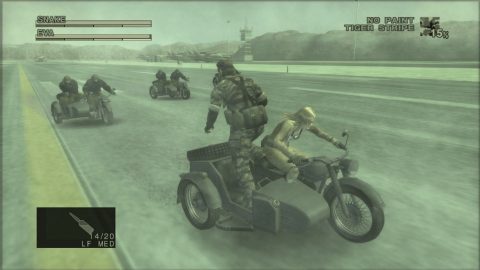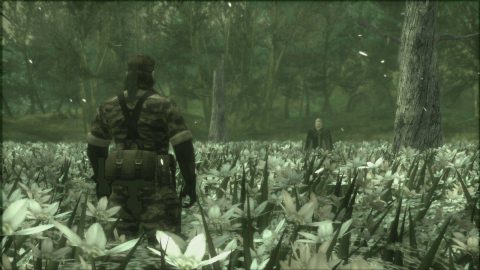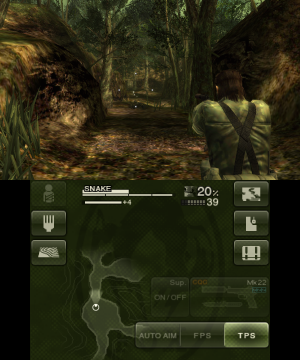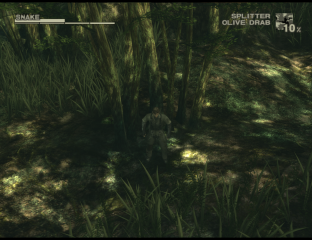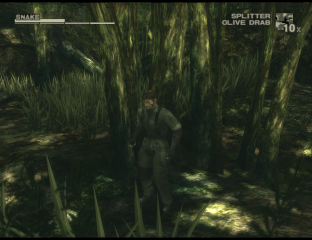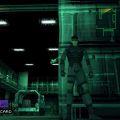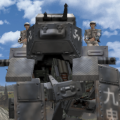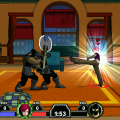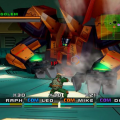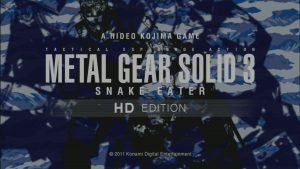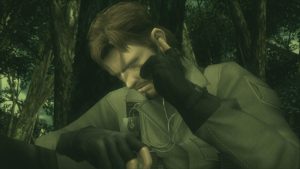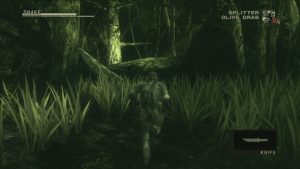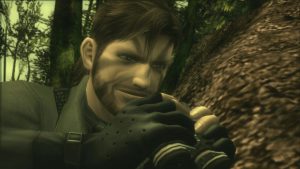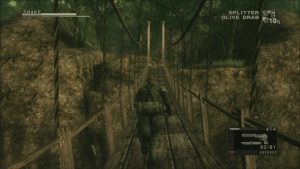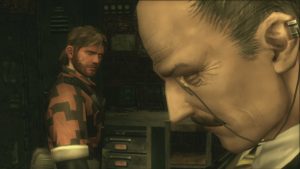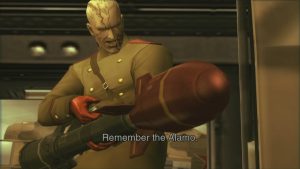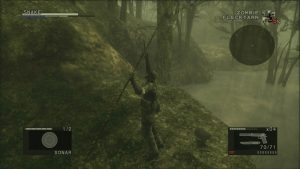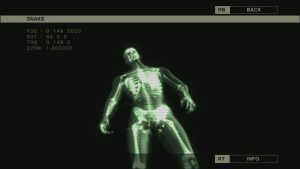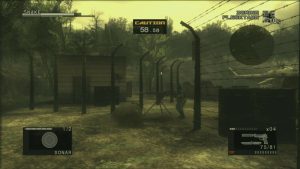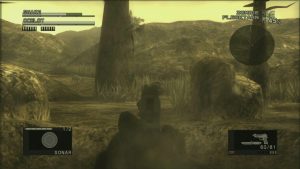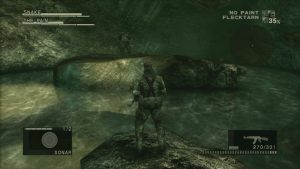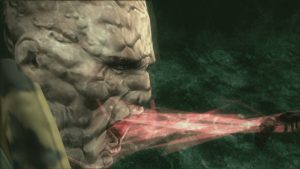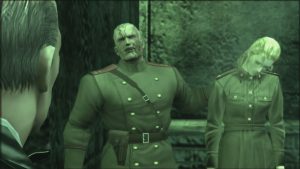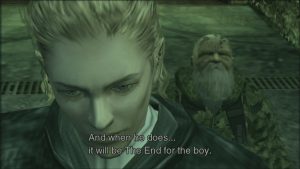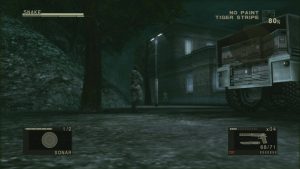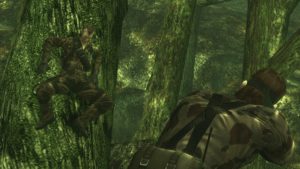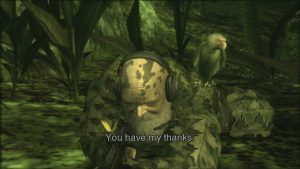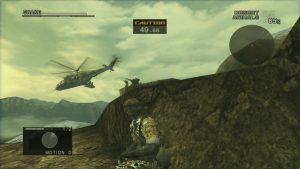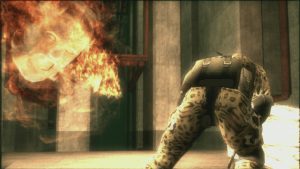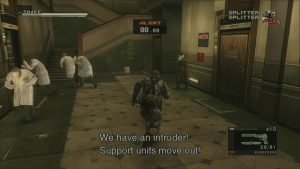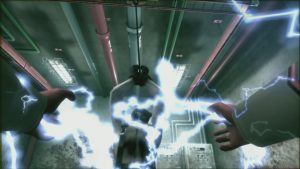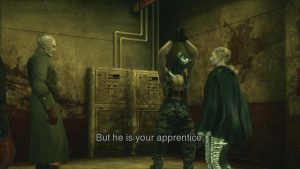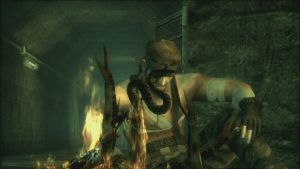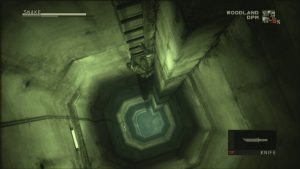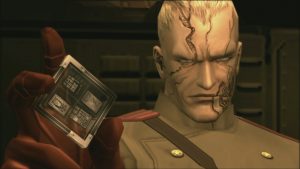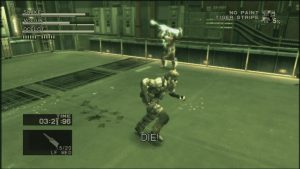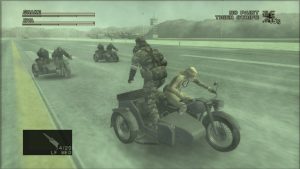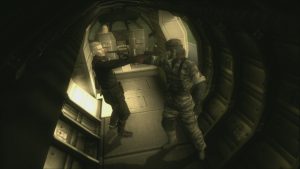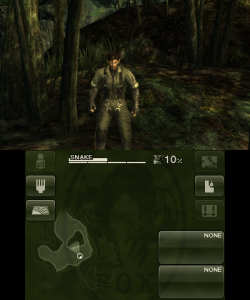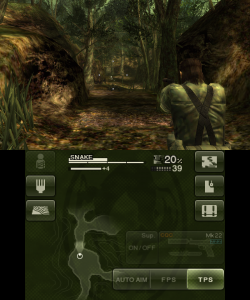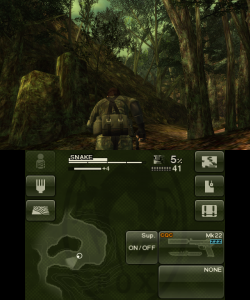- Metal Gear
- Snake’s Revenge
- Metal Gear 2: Solid Snake
- Metal Gear Solid
- Metal Gear Solid Integral Staff Commentary
- Metal Gear Solid (Game Boy Color)
- Metal Gear Solid 2: Sons of Liberty
- Document of Metal Gear Solid 2, The
- Metal Gear Solid: The Twin Snakes
- Metal Gear Solid 3: Snake Eater
- Metal Gear Solid 4: Guns of the Patriots
- Metal Gear Solid: Portable Ops
- Metal Gear Solid: Peace Walker
- Metal Gear Solid V: Ground Zeroes
- Metal Gear Solid V: The Phantom Pain
- Metal Gear Rising: Revengeance
- Metal Gear Touch
- Metal Gear Acid
- Metal Gear Acid 2
- Metal Gear Solid Mobile
“I’m still in a dream…”
There may be few songs as memorable in the Metal Gear series as ‘Snake Eater.’ The jazzy composition, with loud brassy trumpets and a crooning bold voice at the mic, evokes the Cold War super spy, sounding like the theme to a forgotten Bond movie. And indeed, that tracks with the game it comes from. Metal Gear had seen its share of successes and failures but in 2004, Kojima and the team he led crafted something truly magnificent. Metal Gear Solid 3: Snake Eater is an amazingly confident game, the kind of confidence that doesn’t often get seen often these days.
In order to resolve the Cuban Missile Crisis, the US made a secret deal with USSR, returning a defected Russian scientist named Sokolov. It turns out he was working on at top secret nuclear-equipped weapon, the Shagohod, for the Communist country, and Russia kidnapped him back to finish his work. Snake is charged with bringing him back without causing an international stir. Things become complicated quickly when his own mentor, The Boss, and her unit of super powered soldiers, the Cobra Unit, defect to the USSR, and a nuclear weapon of US origin is detonated inside Russian borders. Just a week later, a second operation commences to clean up the mess, forcing Naked Snake against his mentor, with the world ending threat of a new super weapon hanging over him, should he fail.
Characters
Naked Snake
This Green Beret soldier is the man who becomes Big Boss, and the Virtuous Mission is his first solo operation. His codename was bestowed upon him by Major Zero in honor of the Cobra Unit that his mentor, The Boss, commanded. He prefers cigars over cigarettes.
Major Zero
The commanding officer of the Virtuous Mission and Operation Snake Eater, Major Zero provides Snake support over the radio. Born and raised in Britain, he ends up playing a large role in the canonical history of the series.
Para-Medic
Para-Medic works as the medical adviser for Snake’s mission, and also saves the player’s game. She’s a cinema aficionado, so as Snake calls in to record his mission, she regals him with the movies she’s seen, all time period appropriate.
Sigint
Sigint is an expert – the expert, even – at weapons and high tech gadgetry, and he’s quite proud of his inventions. He’s full of insights about the tools Snake finds during his mission. He becomes a familiar character that players have already seen in a previous Metal Gear game.
Sokolov
A scientist with a stylish monocle, Sokolov was creating the Shagohod when he defected to America, only to be returned when it was politically convenient for the country. He wants to make it back home to be with the family he created back in the United States.
Granin
This less stylish scientist still has some big ideas. Granin is Sokolov’s intellectual rival, wanting to be rid of him. He is the origin of Metal Gear, and the idea was passed over for Sokolov’s weapon, the source of the rivalry.
Major Ocelot
Ever the right hand man playing all sides, this younger Ocelot has a bit of a brotherly rivalry with Snake. He summons his team of elite soldiers with a goofy growl. His back story gets more fleshed out in this game.
EVA
EVA is the mysterious woman Snake makes contact with. She’s infiltrated Volgin’s inner circle and provides Snake with intel & help from the inside. She’s quite the gear head for motorcycles, but she seems to have some trouble with zippers.
Volgin
Volgin is a big bad Bond villain mixed with X-Men mutant vibes. For extremely comic book reasons, he can generate electricity with his body, using it to shoot bullets with his hands and punch through solid metal.
The Cobra Unit
The Boss
The Boss is an elite soldier who is focused on the purity of battle. While mentoring Snake, the two of them created Close Quarters Combat, or CQC. The teacher and student parted ways several years prior, only to be reunited by these two missions.
The Pain
The Pain can attract insects using pheromones he gives off. As a result, his face looks like he stuck it in a beehive. Surprisingly, it wasn’t nanomachines but rather parasites that gives him his powers.
The Fear
A master of stealth and jungle warfare, The Fear strikes, well, terror into the hearts of his enemies. He sets up traps throughout the jungle to ensnare Snake, and is adept at poisons. He enjoys toying with his prey.
The End
This centenarian is a patient & calculating sniper. His parrot is almost always near him, his only company during the long hours of waiting for his prey. Like his fellow Cobras, his unnatural long life and keen eye are due to parasites.
The Sorrow
The only one of the Cobra Unit to not be alive, The Sorrow lives on as a spirit. In life, he had an intimate relationship with the Boss. In death, he has an affinity for rain, showing up when thunderstorms are near.
The Fury
The Fury might be the angriest astronaut ever. He was badly burned upon reentry during an early test flight into space, and the experience filled him with rage. Now he wears a fire proof suit, and wields a flamethrower.
Metal Gear Solid 3 excels at pacing, compared to the more freewheeling narratives of earlier games. It employs the same prologue/main story set up from Metal Gear Solid 2 to a greater effect, allowing players to see and understand the interactions between Snake and The Boss, a relationship with a huge influence over the game and the series’ lore. The rookie soldier is caught between his admiration and respect for his mentor, the geopolitical demands of his mission, and the ever changing allegiances around him. And as the intrigue picks up, so does the action. The last third of the game abandons any pretense of stealth, becoming a series of chase sequences and boss fights, culminating in a memorable confrontation with the Boss in a field of white flowers. All is not perfect, however. The game, as the series does, gives women the short end of the stick. It leans too hard into the ‘Bond girl’ trope with EVA and The Boss shows cleavage during the final battle for questionable reasons. Both characters are otherwise interesting, which is why it’s frustrating to seem them get caught up in these kinds of distractions. While the story isn’t as deep as its predecessors, it aspires to be more complex than the typical spy thriller fare.
As solid as the story is, the game also plays superbly. The series’ simple premise of hide and sneak gets some new twists in Metal Gear Solid 3, perhaps the biggest of which is CQC, or Close Quarters Combat. It allows Snake more options to deal with enemies using melee alone. Soldiers can not only be held up, like in Metal Gear Solid 2, but now can also be interrogated for info on items & patrol routes, or used as human shields during a fire fight. It also lets him access to more hand-to-hand fighting techniques while holding smaller arms, like the tranquilizer gun or a pistol. He can now blend in with his surroundings using the new camouflage system. How well he’s hidden is marked by a percentage beside the compass. Using the right camo in the right environments allows Snake to more easily sneak by enemies, where as using the wrong one will make him stand out more. Camo is helpful, given that soldiers have more visibility on Snake and coordinate more efficiently in the complex environments, building on the improvements from the previous game.
Smarter enemies aren’t the only problem Snake has to keep track of either. Snake has to triage his own wounds on the field. Breaking his arm requires different materials to fix compared to a gunshot wound. If he doesn’t heal himself, his injuries will affect his performance, from limiting his health to being unable to run. In the same spirit, Snake’s stamina meter is now directly tied to his stomach. Players will have to hunt & forage for food when Snake gets hungry or he won’t be able to hang or swim as long. How much stamina it restores depends on how good Snake thinks it tastes, and food can spoil or taste bad, causing him to get sick if he eats it. These new additions are unique, but since they all live on the pause screen, they can be cumbersome to manage. Players who aren’t as skilled & take a lot of damage, or who want to take full advantage of the camo system will spend a lot of time menuing, and it breaks the flow of the action, something later games would tackle in different ways.
Where Snake Eater shines, where it excels, is in just jampacked with the whole package is. The opening title sequence has all sorts of little gimmicks and animations available when messing around with the shoulder buttons and analog sticks, including changing the language of the credits. Eating a glowing mushrooms will restore the battery on some items in addition to stamina. Letting the game idle on the game over screen changes the ‘Snake Is Dead’ message into ‘Time Paradox.’ Spinning Snake’s model around on the pause screen will cause him to throw up, a useful trick if he’s suffering from food poisoning. Hidden Codec frequencies (different depending on difficulty level) play easy listening instrumental songs that will heal Snake’s stamina. Holding L1 during different parts of cutscenes can provide an alternate view (sometimes even when not prompted on the screen.) There’s always some unique interaction or charming detail waiting to be found. It’s just crackling with excitement and surprises at every turn.
The game is so excited for people to play that it brings in other games! On the PS2 versions, a mode called ‘Monkey Vs. Snake’ offers 7 levels of catching the simians from Ape Escape, in the first of many crossovers. Colonel Campbell returns to put Snake on an ape-napping mission, with some cheeky references to other stealth heroes of the time. Each mission is named as an ape-based pun on cinema, like ‘Ape Fear’ and ‘Return of the Living Apes.’ Completing this mode gives Snake unlockables for the campaign; a monkey mask that make first person aiming harder and a banana themed camo suit that too bright to work as camouflage but makes all food, rotten or not, taste good. And if monkeys are enough, then there’s more! During a sequence where Snake falls asleep (and also only in the PS2 versions,) the player is presented a rudimentary character action game, known as ‘Guy Savage’ thanks to data miners, where a man with hook swords attacks endless hordes of zombies. The game was based on an abandoned prototype, directed by Shuyo Murata, for a Zone of the Enders sequel that never materialized. Supposedly, the team wanted to include Gradius, but went with the prototype instead.
The boss fight with The End is a shining display of this team of developers’ exuberant, intricate design, in particular. The distinct ways which it can be completed are unmatched. If you can think of how to tackle it, the designers got there too, including using the actual hardware you’re playing on or even taking the boss out ahead of time. That attention to detail, the ability to intuit what a player might do in order to overcome an obstacle, is, well, it just doesn’t exist anymore. In a world of lootboxes and battle passes, of maximizing ‘engagement’ to a brutal degree, The End could never exist. There are no ways in which Genshin Impact, Destiny 2, or any other live service game could ever replicate the design of this particular boss fight, or, for that matter, this game.
The game also pushed the technical limits of the time. Initially, development targeted the PS3, but Sony’s next gen machine took longer to materialize than anticipated, so the game landed on the PS2 instead. The environments of the previous two games, despite their details, were ultimately boxy, industrial locals. Snake Eater begins in a jungle with all diverse geometry it takes to paint that picture. Snakes, frogs, rabbits, and more are found traipsing around levels, ready for hunting. The grass surrounds Snake as he crawls through it. Even as levels become more abandoned factory and military base, they remain varied and interesting for the duration of the game. The complexities of the environments means players have more to keep track of, if just to avoid getting chomped on by alligators or catching a stray sniper bullet a few floors above. Facial animations were improved, with characters emoting more convincingly. Cutscenes feature the use of splitscreen on a few occasions, a technique the PS3 sequel would expand into gameplay. The extra detail necessitated lower performance target, but it remains largely consistent, just like its predecessors. It’s quite the accomplishment, and shows just how much of a handle the team had on the PS2’s workings.
Musically, the game was a collaboration between series-familiar composers. Harry Gregson-Williams and Norihiko Hibino worked together to score Metal Gear Solid 3, along with contributions by Shuichi Kobori and Nobuko Toda. The soundtrack is given a Cold War spin, including the ‘Metal Gear Solid Main Theme.’ Cynthia Harrell provides the vocals for the titular song, composed by Hibino. In an interesting change of pace, the game closes with a licensed track, a song by British band Starsailor called ‘Way to Fall’, in addition to an in-house composition, ‘Don’t Be Afraid,’ written by Rika Muranaka and performed by Elisa Fiorillo.
As should come as no surprise at this point, Metal Gear Solid 3 got a revised edition a year later in 2005, with a new subtitle, Subsistence. It goes a different route for adding new content. Specifically, by going back to the past and looking to the future. Both MSX2 games are included, in all territories, based on a version released on feature phones in Japan a year earlier. This marked the first time either of these games had been seen in North America. The more future facing addition was Metal Gear Online. This new online mode, which will be covered in a separate article, motivated a big change in the gameplay department. Subsistence added the option to control the camera with the right analog stick, with the ability to switch between the original overhead style and new one at the click of a button. The new camera brings the game in line with other third person action games of the time. This was the version, sans Online and simians, that was ported by Bluepoint Games as part of Metal Gear Solid HD Collection on Xbox 360 and PS3, and to the Vita, courtesy of Armature Games. NVidia also used this version for their port of the game to the Shield, their Android-based microconsole, in late 2017. Due to licensing expiring for live action footage in the game, Konami delisted the HD Collection off of digital stores in November 2021.
Snake Eater got a second unique edition, becoming even more ‘Solid’ on the Nintendo 3DS. At E3 2010, Konami showed off a tech demo based on the game for Nintendo’s then-unreleased handheld, merely as an example of the possibilities with the new device. It eventually evolved into a full port, released in early 2012, as Metal Gear Solid: Snake Eater 3D. It is essentially the same game adapted to fit on the 3DS, lacking the extras from Subsistence. Compared to the PS2 original, the console lacks two more shoulder buttons and one more analog input, so the adapted control scheme is cramped and confusing. Unless one of the console’s enhanced editions (or the Circle Pad Pro attachment for the earlier models) is used, that is. The later revisions’ extra analog stick and shoulder buttons allow it to control on par with the original. The game features higher detail models and textures compared to the original, but it has some struggles performing, even on enhanced models. And this is without the system doing what it’s known for, 3D stereoscopic images, which compromises performance further. Like The Twin Snakes before it, Nintendo references are peppered through out. As with the HD Collection, it was delisted from the eShop at the end of 2021 as well.
People who like video games like to hyperbolize. They are prone to exaggeration, always with the GOATs and listicles, perhaps more so than any other hobby or enthusiast industry. It is not, however, an exaggeration to call Metal Gear Solid 3 a sublime, landmark title. It is not perfect – nothing ever is – and it continues to traffic in the same narrative failings that have dragged the series down, but it was also created with an attention to detail, design, and pacing, by creators operating at the pinnacle of their craft. It’s an inviting game that revels in being played. This is as good as it gets for the series. Metal Gear Solid 3: Snake Eater is the right amount of Metal Gear, something that cannot be said about some of the games that follow.
